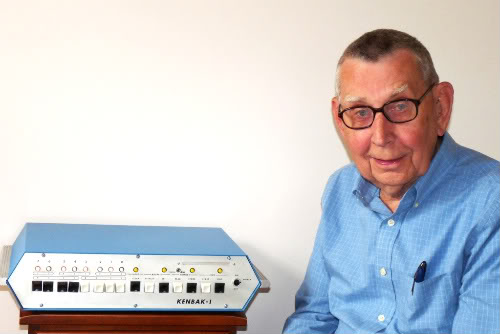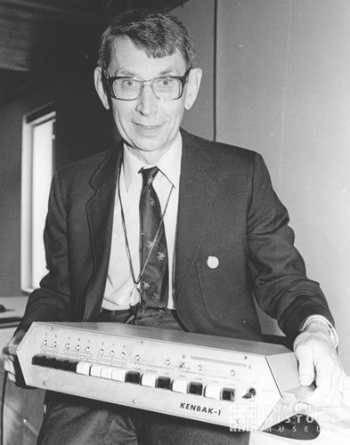
The Kenbak-1 computer, built in 1971, is considered by many computer historians to represent the world's first personal computer. This Kenbak-1 computer, serial number 183, has been in the possession of its creator John V. Blankenbaker since 1971, and has been recently restored by him to be fully operational. Kenbak-1 computers are scarce and considered to be highly collectible. On rare occasions when one has been offered for sale, they have sold for between $10,000 and $15,000.
This Kenbak-1 computer, serial number 183, is from Kenbak Corporation's first and only production run of fewer than 50 computers. Since the serial numbers started with 167, this particular machine was the seventeenth in the sequence. It is the only production Kenbak-1 computer in the possession of John Blankenbaker and therefore will be the last one that he puts on the market.
The auction includes these items shown in the photos below:
History of the Kenbak-1
The Kenbak-1 is considered by many to be "the world's first personal computer." The Computer Museum of Boston granted it this designation in 1986. More specifically, the machine represents the first commercially available Von Neumann (stored program) computing device intended and priced for personal use. Designed by John V. Blankenbaker using standard medium-scale and small-scale integrated circuits, the Kenbak-1 relied on switches for input and lights for output from its 256-byte memory. The Kenbak-1 was advertised in Scientific American for $750. During much of its history, Kenbak Corporation operated out of Mr. Blankenbaker's garage in West Los Angeles. In 1973, after selling only 40 machines, Kenbak closed its doors.
History of computer number 183
During Kenbak's original production run, problems were found with number 183, but never corrected and the machine remained in limbo. When Kenbak Corporation ceased operations, a few completed machines were sold but John Blankenbaker kept the prototype and two production machines, including number 183. The other production run computer was given to the Computer Museum of Boston in 1987 and it is now in the possession of the Computer History Museum in Mountain View, CA. (You can see it pictured on the museum's computer history timeline).
About the process of restoration Mr. Blankenbaker says, "The problems in serial number 183 have been corrected and the machine is operational 39 years after it was first built in 1971. Bringing it to the finished state and fully operational was not easy. One handle had been lost and it was necessary to have a duplicate one machined. Three integrated circuits and one transistor were replaced. The main power supply filter capacitor was replaced though the original one was probably okay. The lamps were replaced with a different mechanical configuration though the same lamp type is used. The switches on the front panel were remounted and without the original alignment fixture the resulting positions are slightly in error. There are two very small scratches on the top surface."
Number 183 is operational and executing all of its instructions. It is the only production Kenbak-1 computer in the possession of John Blankenbaker. Mr. Blankenbaker describes himself now as "an octogenarian with other interests." He is retaining the prototype Kenbak-1 computer for his heirs.
For a great deal more information about Kenbak's operation, design and history, see John Blankenbaker's own website, www.kenbak-1.net.
Payment and shipping:
Payment must be through Paypal (as required by Ebay). If the buyer uses Paypal to arrange a bank transfer, there are no extra fees on the transaction. If the buyer wishes to use a credit card through Paypal, he or she will be responsible for the additional Paypal fees (approximately 3 percent of the purchase price). The Paypal escrow service can be used if the buyer wishes.Shipping will be by UPS within the US. The cost of shipping depends on the destination. The Kenbak-1 alone is 19.25" wide, 4.5" high, and 21" deep. In a well-padded container it weighs about 20 pounds. Depending on your location, the cost of shipping UPS may range from 15 to 35 dollars. International customers, please ask for a shipping quote before the end of the auction to avoid surprises.
The auction is being handled by Mr. Blankenbaker's daughter, Anne B. Killheffer (arrowbooks), who will forward any questions to her father during the auction and post his replies.

Mr. Blankenbaker today with Kenbak-1 number 183.

The printed material included in the auction.

Mr. Blankenbaker with the Kenbak-1 that was given to the Computer Museum in Boston in 1987. (Now in the collection of the Computer History Museum, Mountain View, CA)

^ The ad that appeared in Scientific American in Sept. 1971. A copy of the ad will be included in the auction.
Several people have asked me for more close-up pictures, especially of the interior, to show the details of the restoration work. I asked my dad to take some new shots and he agreed to open up the Kenbak-1 and take some new photos. I will post them when I receive them; I hope it will be as soon as this weekend.
Also, if you are interested in the exact details of the restoration process, my dad gives more details on his own website, http://www.kenbak-1.net/index_files/serial_138.pdf